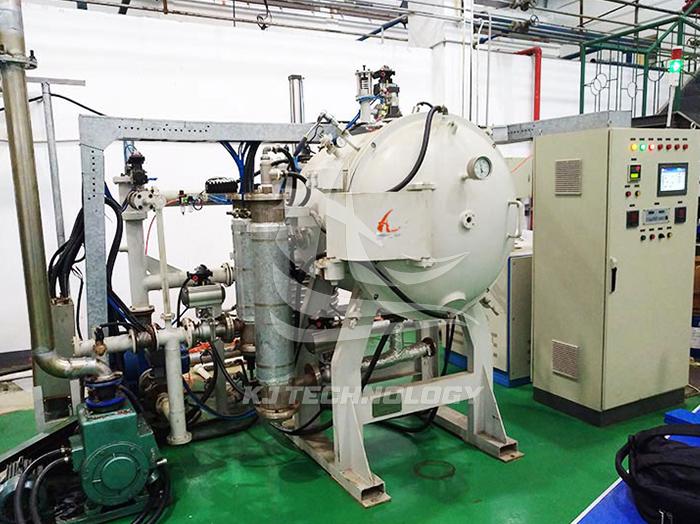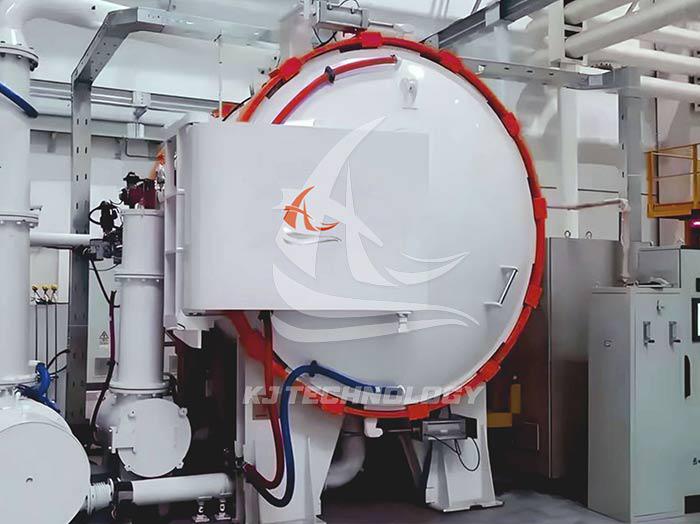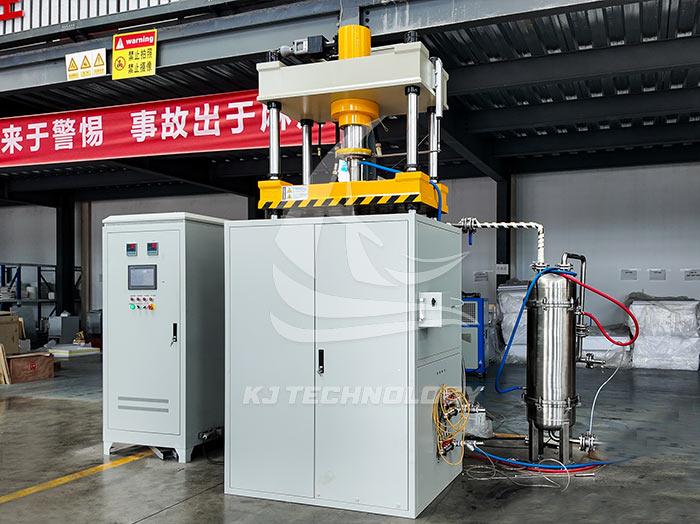Precautions for using a vertical high vacuum hot pressing electric furnace
 08-20-2025 Author: KJ technology
08-20-2025 Author: KJ technology
As a high-precision and high-value equipment, the vertical high vacuum hot press electric furnace is widely used in high-end manufacturing fields such as semiconductors and batteries. However, its operation involves complex environments such as high temperature, high pressure, and vacuum. Improper use may lead to equipment damage, experimental failure, and even safety accidents. The following are the key precautions to pay attention to when using a vertical high vacuum hot pressing electric furnace:
1. Preparation before operation
environment check
Venue requirements: The equipment should be placed in a dry, ventilated, and non corrosive gas environment, away from vibration sources and strong electromagnetic interference, ensuring a flat ground and load-bearing capacity that meets equipment requirements (such as furnace body weight+full load weight).
Power and gas source: Check if the power supply voltage (such as 380V ± 10%) and frequency (50/60Hz) match the equipment requirements; Confirm that the supply of cooling water, compressed air, inert gases (such as argon, nitrogen), etc. is sufficient and the pressure is stable (such as cooling water pressure ≥ 0.2MPa).
Equipment inspection
Appearance inspection: Check whether the sealing parts of the furnace body, furnace door, observation window, etc. are intact, without cracks or deformations; Confirm that key components such as heating elements, thermocouples, and pressure sensors are securely connected without looseness or damage.
Vacuum system inspection: Check if the oil level of the vacuum pump is normal (such as if the oil level of the mechanical pump is at 1/2-2/3 of the oil window), and confirm that there are no leaks in the vacuum pipeline (which can be detected by applying soapy water or using a helium mass spectrometer leak detector).
Hydraulic system inspection: Check whether the hydraulic oil level is within the specified range, confirm that there is no leakage in the hydraulic pipeline, and that the pressure gauge displays normally (such as pressure range 0-100MPa).
Tooling and sample preparation
Fixture selection: Choose suitable fixtures (such as graphite molds, molybdenum boats, ceramic trays) based on the material and process requirements of the sample, ensuring that the fixtures are resistant to high temperatures (such as graphite temperature ≥ 2000 ℃), corrosion-resistant, and have no chemical reaction with the sample.
Sample processing: The sample needs to be cleaned and dried to avoid oil stains, moisture, or impurities affecting the vacuum degree; For volatile or oxidizable materials, they need to be pre treated in a glove box and sealed before being transferred to the furnace.
2. Precautions during operation
Vacuum system operation
Vacuum pumping sequence: First, start the mechanical pump to pre pump to low vacuum (such as below 10 ³ Pa), then start the molecular pump or diffusion pump to pump to high vacuum (such as 10 ⁻⁵ Pa). If the high vacuum pump is directly started, the pump body may be damaged due to excessive pressure difference.
Vacuum monitoring: Real time observation of vacuum gauge readings. If the vacuum drops too quickly or cannot reach the set value, heating should be stopped immediately and leakage points (such as furnace door seals, observation windows, vacuum valves, etc.) should be checked.
Vacuum breaking operation: After the experiment is completed, inert gas (such as argon) should be filled to atmospheric pressure before opening the furnace door to prevent rapid air from entering and causing sample oxidation or damage to furnace components.
Heating and pressure control
Heating rate: Strictly control the heating rate according to the process curve (such as 5-10 ℃/min) to avoid rapid heating that may cause sample cracking or excessive thermal stress on furnace components.
Pressure application: Apply pressure after the temperature reaches the set value (such as heating up to 800 ℃ and then applying pressure to 50MPa) to prevent material deformation or fixture damage at low temperatures; The pressure needs to be slowly increased to the target value to avoid impact loads.
Temperature uniformity: Regularly calibrate the position of thermocouples to ensure temperature uniformity within ± 5 ℃ inside the furnace; For large-sized samples, zone temperature control or rotating furnace technology should be used to improve temperature distribution.
atmosphere control
Inert gas protection: Materials sensitive to oxygen, such as lithium metal and sulfide electrolytes, need to be filled with high-purity inert gas (such as 99.999% argon) under vacuum and maintained at a positive pressure (such as 0.01-0.1MPa) to prevent air infiltration.
Reaction gas introduction: If reaction gases (such as hydrogen and ammonia) need to be introduced, the flow rate should be precisely controlled by a mass flow meter (such as 10-100sccm), and the gas purity (such as H ₂ ≥ 99.999%) should be ensured to avoid impurity contamination.
3. Safety protection measures
personal protection
Operators are required to wear protective goggles, heat-resistant gloves, gas masks (if handling toxic materials), and anti-static clothing to avoid accidents caused by high temperature burns, inhalation of toxic gases, or static sparks.
Wearing metal jewelry or carrying flammable materials into the operating area is prohibited to prevent electric shock or fire.
Equipment safety
Overtemperature protection: Set a temperature upper limit alarm (such as 50 ℃ higher than the target temperature), automatically cut off the heating power and start the cooling system when the temperature exceeds the limit.
Overpressure protection: Equipped with pressure safety valves (such as rupture discs or spring type safety valves), which automatically release pressure when the pressure exceeds the set value (such as 120% of the rated pressure) to prevent equipment explosion.
Emergency stop: An obvious emergency stop button should be installed outside the furnace body, and the operator can immediately stop the equipment operation in case of emergency (such as vacuum leakage, fire).
emergency response
Fire response: If a fire occurs in the furnace or pipeline, immediately cut off the power and gas sources, use dry powder fire extinguishers or carbon dioxide fire extinguishers to extinguish the fire, and prohibit using water to extinguish the fire (which may cause electric shock or equipment damage).
Vacuum leakage treatment: When the vacuum degree drops sharply, heating should be stopped immediately and all valves should be closed. After locating the leakage point with a leak detector, it should be repaired; If the leakage cannot be controlled, the emergency exhaust system needs to be activated and personnel evacuated.
4. Maintenance and upkeep
routine maintenance
Cleaning the furnace body: After each experiment, wipe the inner wall and observation window of the furnace body with a dust-free cloth to avoid residue affecting the next experiment; Regularly clean the vacuum pump oil filter (e.g. every 50 hours) and cooling water filter (e.g. every 100 hours).
Lubrication and maintenance: Regularly apply high-temperature resistant grease (such as molybdenum disulfide grease) to the moving parts of the hydraulic system, such as pistons and guide rails, to reduce wear and extend service life.
Regular maintenance
Vacuum system maintenance: Replace the vacuum pump oil every 3-6 months (if the mechanical pump oil needs to be replaced every 300 hours), check the sealing of the vacuum valve, and replace the aging sealing ring.
Heating element maintenance: Check the resistance value of heating elements (such as silicon molybdenum rods and graphite heaters) annually, and replace them if the deviation exceeds 10%; Clean the surface oxide layer of the heating element (such as sanding with sandpaper) to improve heating efficiency.
Pressure sensor calibration: Calibrate the pressure sensor every 1-2 years (such as by comparing with a standard pressure source) to ensure that the pressure display accuracy is within ± 1%.
Long term disuse maintenance
If the equipment is not used for a long time (such as more than one month), the cooling water, hydraulic oil, and vacuum pump oil should be drained to prevent pipeline corrosion; Place desiccants (such as silica gel) inside the furnace and seal the furnace door to prevent moist air from entering and causing component oxidation.








